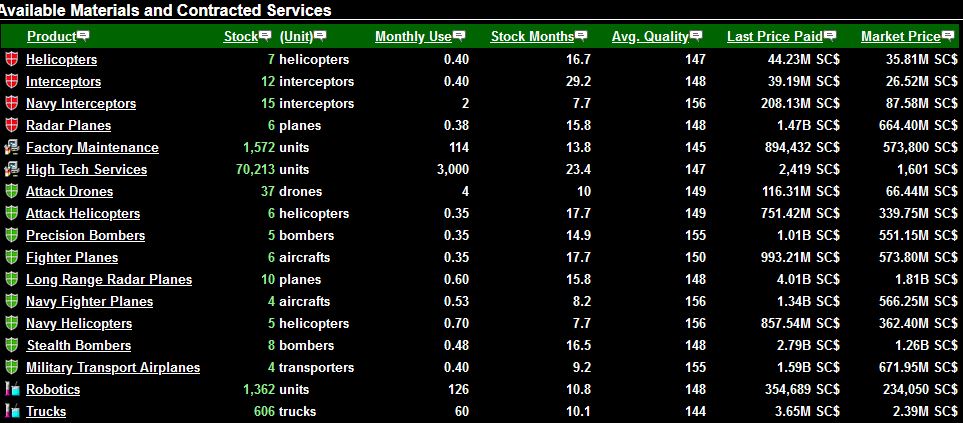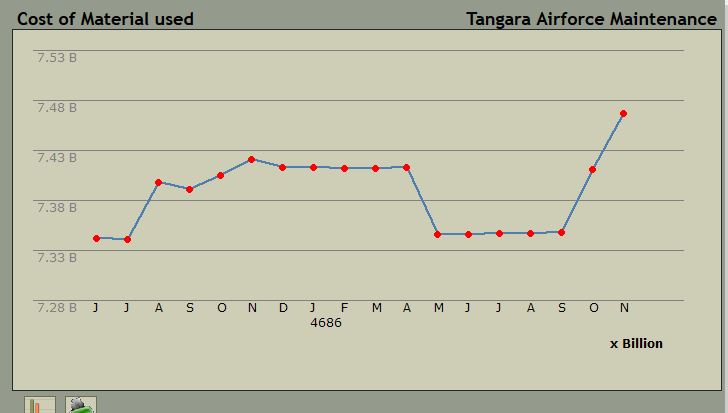| Hern | Monday, April 11, 2022 - 04:56 pm 
So I've been trying to understand why one of my Airforce Maintenance corporations seems to be struggling worse and worse despite it supposedly making 30B net profit a year.
I ran the numbers on its raw materials usage. Seeing as this is a Maint corp, 90% of its products are immediately purchased whenever I get around to it, dramatically increasing the cost of the products. The last price paid is accurate, based on the sales logs and the difference in "cash available" when a purchase is made immediately. So everything up to that point is functioning appropriately.
I did find an issue with the "Profit & Loss - Current Month". The raw materials total there does not reflect a sum of the monthly use * last price paid. In fact, I can't seem to surmise what the raw materials cost is. It's not base price. It's not the real price. It doesn't seem to be quality-adjusted price either. It doesn't really matter, this value should just be the last price paid * monthly usage.
As far as my corporation goes, because it appears to be making a large profit, it is in fact paying taxes greater than its REAL profit. This is causing its slow demise. |
| Andy | Wednesday, April 13, 2022 - 10:04 am 
The monthly usage is many times quite stable.
the corporation is using similar numbers each month and there might be some small fluctuations.
however,
The amount spent on buying materials, is not the same as the cost for the month.
one month you buy nothing and use what you have,
another month you buy large quantities and pay many billions.
the purchasing is not cost.
it is an investment in raw materials. you change cash into raw material assets.
the month use is the cost. the value of materials you have declines by the quantities you use.
I hope this is clear enough. |
| Hern | Wednesday, April 13, 2022 - 04:33 pm 
The monthly cost in the "Profit & Loss - Current Month" does not match the actual costs of the materials. I know costs are sporadic and as needed, I'm not talking about the "Raw Materials Bought" line at all. I'm talking about the "Raw Materials Used"
If you multiply the Last Price Paid by the Monthly Use for these corporations that have many immediate purchases, the cost is much higher than the Raw Materials Used claims.
Here's the table for an Airforce Maintenance Corporation
| Product | Monthly Use | Last Price Paid (M) | Use * Price | | Helicopters | 0.4 | 44.23 | 17.692 | | Interceptors | 0.4 | 39.19 | 15.676 | | Navy Ints | 2 | 208.13 | 416.26 | | Radar Planes | 0.38 | 1470 | 558.6 | | Factory Maint | 114 | 0.894432 | 101.965248 | | High Tech Service | 3000 | 0.002419 | 7.257 | | Attack Drones | 4 | 116.31 | 465.24 | | Attack Helis | 0.35 | 751.42 | 262.997 | | Precision B | 0.35 | 1010 | 353.5 | | Fighters | 0.35 | 993.21 | 347.6235 | | LR Radar | 0.6 | 4010 | 2406 | | Navy Fighters | 0.53 | 1340 | 710.2 | | Navy Helis | 0.7 | 857.54 | 600.278 | | Stealth B | 0.48 | 2790 | 1339.2 | | Military Trans | 0.4 | 1590 | 636 | | Robotics | 126 | 0.354689 | 44.690814 | | Trucks | 60 | 3.65 | 219 | | | | 8502.18 |
Total Monthly Use: 8502.18
That's the value I should see in Raw Materials Used, but instead I see: 7413.79
And I know that Raw Materials Used should actually be at the accelerated rate of the efficiency of the corporation, which is 125.5%. If we were to increase the monthly use to 125.5%, we can get an idea of just how much tax/profit share I'm overpaying. 8502.18 * 1.255 = 10670
That's a difference of 3.256 B$ !!!! This corporation "supposedly" made 5.1B in profit, but in reality it was only 1.844B!
That means I paid over 1B in tax that shouldn't exist.
Here's some pictures showing the same data, just to be clear.
Current month

Products in stock

Andy, the calculation for Raw Materials Used is wrong. |
| Hern | Wednesday, April 13, 2022 - 04:59 pm 
Apparently the picture tag requires the curly braces... |
| Hern | Wednesday, April 13, 2022 - 05:00 pm 

 |
| Andy | Wednesday, April 13, 2022 - 08:28 pm 
Thank you for the work you have done to document all this.
What you are saying is that the line with "Raw materials used" should show 10760 (instead of 7413).
This is the number you computed.
The computation was checked many times in the past and I am quite sure it is OK.
The cost as shown on the page (&413), is also subtracted from the value of raw materials.
If this amount is lawer by 3B per month than the amount that should be subtracted, then the value of raw materials should increase in time and become absurdly high.
it does not.
please check the raw materials number. we could learn from it.
I will have someone look into it. it will take some time.
There are many factors you can not compute accurately.
There are time differences between the trade and the recording of the market price. I am not sure when it is done.
also that last price paid is not necessarily the last price you paid. It could be the last price in the trade session while it fluctuates during the session.
Come to think of it, I am not even sure that the welfare index bonus that improves the output of the corporations is causing it to use more raw materials or that the difference is kind of a bonus for the corporation for its higher welfare.
If we increase the cost of raw materials, the effect of the welfare boost is nearly eliminated. |
| Hern | Wednesday, April 13, 2022 - 08:54 pm 
I believe the calculation works fine - or nearly so - for supplies that are no bought immediately. This problem seems to only occur for immediately bought products. With the crazy shortages, this becomes a lot more apparent.
Perhaps there is a max() or min() call that doesn't take into account the extra cost of an immediate order? Similar to the trade strategies page, where there is a hidden limit? I'm just guessing. |
| Hern | Wednesday, April 13, 2022 - 09:04 pm 
Also, the supplies never reflect the real cost. Here's the same corporation.
 |
| Andy | Wednesday, April 13, 2022 - 09:45 pm 
immediate purchases always carry an extra cost. |
| Hern | Wednesday, April 13, 2022 - 09:54 pm 
Of course, and that cost is reflected in the "Last Price Paid" |
| neutralsc | Thursday, April 14, 2022 - 01:43 pm 
Last Price Paid is not the same as average Price Paid or the particular price paid for the resource used in the current month.
If you buy 5 amounts at 10
later you buy 5 amounts at 20
last price paid will state 20
but the price paid for 5+5 is not 20 per 1. Its on average 15 per 1. |
| Hern | Thursday, April 14, 2022 - 04:03 pm 
Fair point, but in this situation they're always being bought with immediate orders, so the price is almost always the same. |
| Andy | Sunday, April 17, 2022 - 06:15 pm 
This is not true.
There are many fluctuations all the time and the end price for the month does not reflect the price during trading.
the transactions are executed against whatever is matched against them.
many times there is no perfect fit and the trading process must make a fit.
this happens on the real market too but the spread in the real world is much smaller. Many orders here are at market price and can cause larger fluctuations.
You can check the transactions log. I did not do that for some time but I remember that when this was tested we had major surprises and it was hard to follow.
The price during trading is not recorded anywhere. it is in memory and used until one side of the queue runs out of steam.
then the price is stored. Later, another round of trading starts with that stored price, with new queues. this happens 6 or 7 times during each game month. The entire month run takes 40 to 80 minutes depending on the size of the world. |
| Hern | Monday, April 18, 2022 - 04:40 pm 
There are no fluctuations with these goods because they don't exist. I'm talking about stuff like Long Range Radar Planes, where the supply is 400 and the demand is 30000 right now.
Immediate orders create "backorders" where the object doesn't exist now but the market is indebted to its creation. When I create an immediate order for a quality 120 product that is never has any stock, like LRRP or Stealth Bombers or anything like that, then it will always be backordered. So it will always have the same price: base_price * 120% qaulity * 200% immediate surcharge. That's how it is (though maybe the 200% is wrong, I can't remember exactly) |

